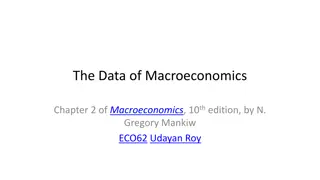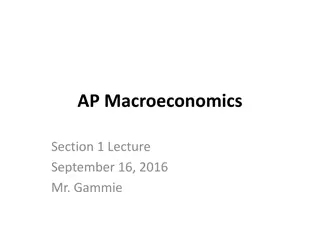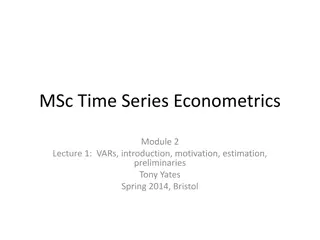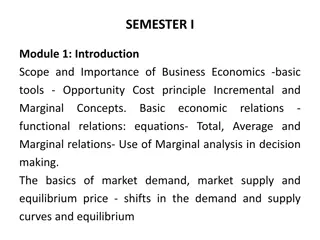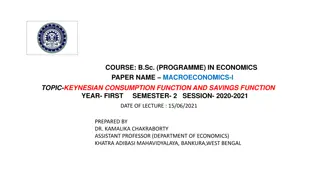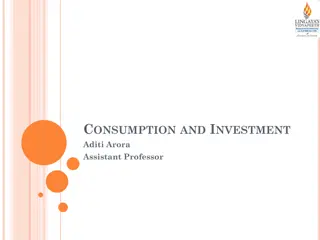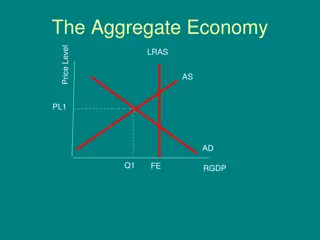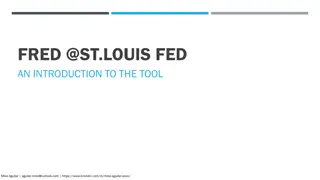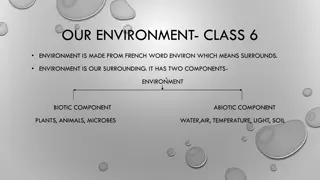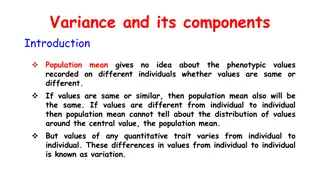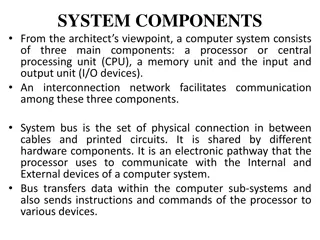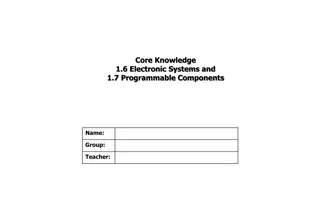Understanding Macroeconomics: Key Concepts and Components
Dive into the world of macroeconomics with a focus on Gross Domestic Product (GDP), value added, circular flow of income, and expenditure components. Learn about the relationship between expenditure and income, the calculation of value added, and the distinction between final goods and intermediate goods in GDP calculations.
Download Presentation

Please find below an Image/Link to download the presentation.
The content on the website is provided AS IS for your information and personal use only. It may not be sold, licensed, or shared on other websites without obtaining consent from the author. Download presentation by click this link. If you encounter any issues during the download, it is possible that the publisher has removed the file from their server.
E N D
Presentation Transcript
THE MACROECONOMICS VARIABLE Design and deliver beautiful presentations with ease and confidence.
Gross Domestic Product: Expenditure and Income Two definitions: Total expenditure on domestically-produced final goods and services. Total income earned by domestically-located factors of production. Expenditure equals income because every dollar spent by a buyer becomes income to the seller. CHAPTER 2 The Data of Macroeconomics
The Circular Flow Income ($) Labor Firms Households Goods Expenditure ($) CHAPTER 2 The Data of Macroeconomics
Value added definition: A firm s value added is the value of its output minus the value of the intermediate goods the firm used to produce that output. CHAPTER 2 The Data of Macroeconomics
Exercise: (Problem 2, p. 40) A farmer grows a bushel of wheat and sells it to a miller for $1.00. The miller turns the wheat into flour and sells it to a baker for $3.00. The baker uses the flour to make a loaf of bread and sells it to an engineer for $6.00. The engineer eats the bread. Compute & compare value added at each stage of production and GDP CHAPTER 2 The Data of Macroeconomics
Final goods, value added, and GDP GDP = value of final goods produced = sum of value added at all stages of production. The value of the final goods already includes the value of the intermediate goods, so including intermediate and final goods in GDP would be double-counting. CHAPTER 2 The Data of Macroeconomics
The expenditure components of GDP consumption investment government spending net exports CHAPTER 2 The Data of Macroeconomics
Consumption (C) definition: The value of all goods and services bought by households. Includes: durable goods last a long time ex: cars, home appliances nondurable goods last a short time ex: food, clothing services work done for consumers ex: dry cleaning, air travel. CHAPTER 2 The Data of Macroeconomics
Investment (I) Definition 1: Spending on [the factor of production] capital. Definition 2: Spending on goods bought for future use Includes: business fixed investment Spending on plant and equipment that firms will use to produce other goods & services. residential fixed investment Spending on housing units by consumers and landlords. inventory investment The change in the value of all firms inventories. CHAPTER 2 The Data of Macroeconomics
Investment vs. Capital Note: Investment is spending on new capital. Example (assumes no depreciation): 1/1/2006: economy has $500b worth of capital during 2006: investment = $60b 1/1/2007: economy will have $560b worth of capital CHAPTER 2 The Data of Macroeconomics
Stocks vs. Flows A stock is a quantity measured at a point in time. Stock Flow E.g., The U.S. capital stock was $26 trillion on January 1, 2006. A flow is a quantity measured per unit of time. E.g., U.S. investment was $2.5 trillion during 2006. CHAPTER 2 The Data of Macroeconomics
Stocks vs. Flows - examples stock flow a person s annual saving a person s wealth # of people with college degrees # of new college graduates this year the govt debt the govt budget deficit CHAPTER 2 The Data of Macroeconomics
Now you try: Stock or flow? the balance on your credit card statement how much you study economics outside of class the size of your compact disc collection the inflation rate the unemployment rate CHAPTER 2 The Data of Macroeconomics
Government spending (G) G includes all government spending on goods and services.. G excludes transfer payments (e.g., unemployment insurance payments), because they do not represent spending on goods and services. CHAPTER 2 The Data of Macroeconomics
Net exports: NX = EX IM def: The value of total exports (EX) minus the value of total imports (IM).
An important identity Y = C + I + G + NX aggregate expenditure value of total output CHAPTER 2 The Data of Macroeconomics
A question for you: Suppose a firm produces $10 million worth of final goods but only sells $9 million worth. Does this violate the expenditure = output identity? CHAPTER 2 The Data of Macroeconomics
Why output = expenditure Unsold output goes into inventory, and is counted as inventory investment whether or not the inventory buildup was intentional. In effect, we are assuming that firms purchase their unsold output. CHAPTER 2 The Data of Macroeconomics
GDP: An important and versatile concept We have now seen that GDP measures total income total output total expenditure the sum of value-added at all stages in the production of final goods CHAPTER 2 The Data of Macroeconomics
GNP vs. GDP Gross National Product (GNP): Total income earned by the nation s factors of production, regardless of where located. Gross Domestic Product (GDP): Total income earned by domestically-located factors of production, regardless of nationality. (GNP GDP) = (factor payments from abroad) (factor payments to abroad) CHAPTER 2 The Data of Macroeconomics
Discussion question: In your country, which would you want to be bigger, GDP, or GNP? Why? CHAPTER 2 The Data of Macroeconomics




